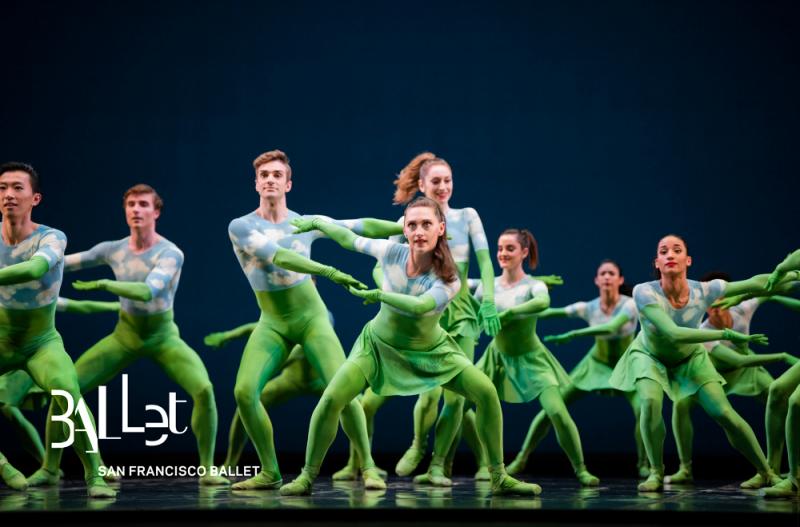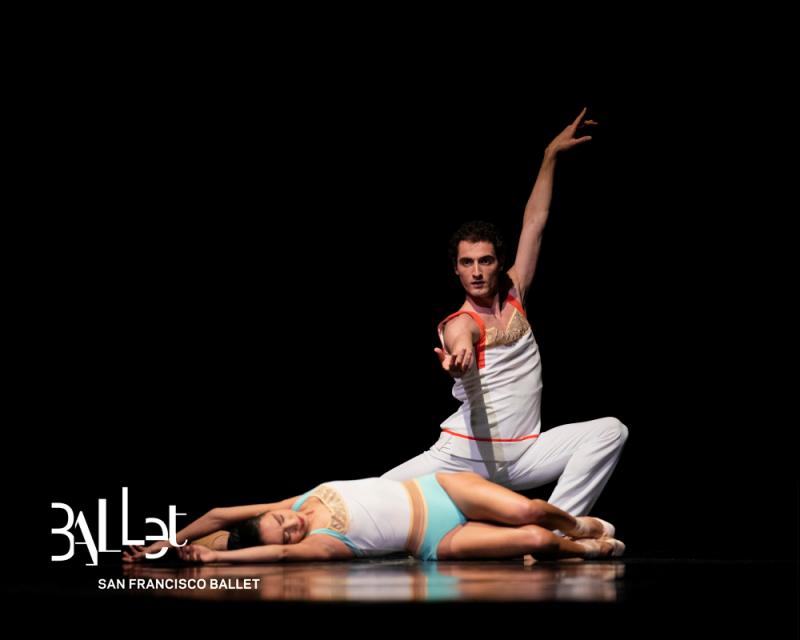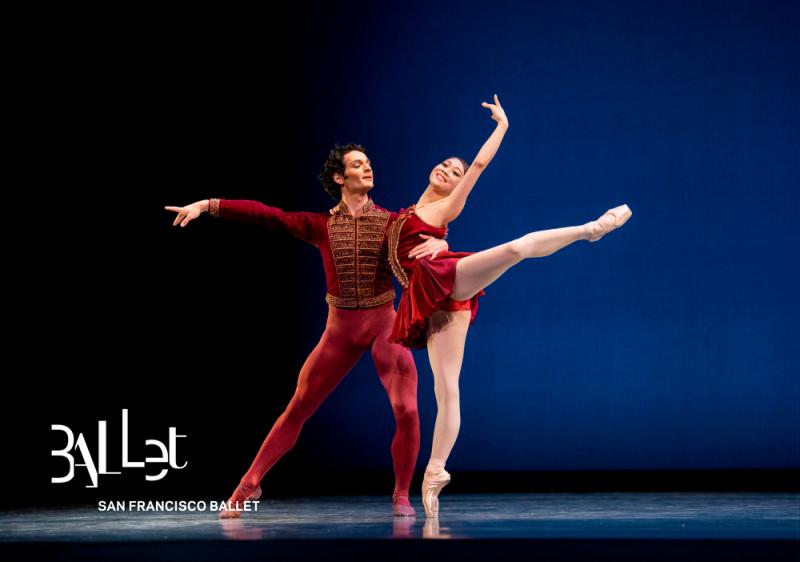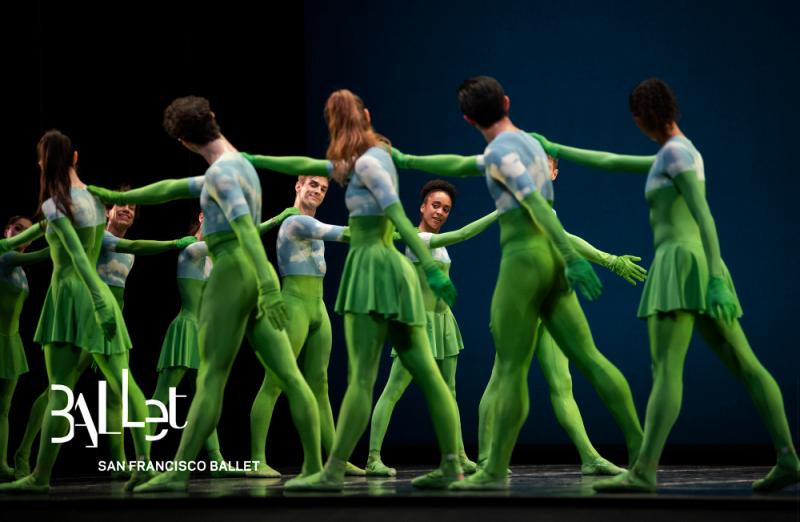Review: CLASSICAL (RE)VISION at San Francisco Ballet Offers a Sparkling Program of Contemporary Dance

How lucky we are to be living in the age of Mark Morris! But, let me back up - My first thought watching San Francisco Ballet's opening night performance of their "Classical (Re)Vision" program was actually "God, they're good!" This is hardly surprising given that the opening piece was Stanton Welch's "Bespoke" which, as the title implies, was made expressly for SFB. Welch clearly loves the company and uses the piece to show off their assets, specifically their knockout technique, clean line, facility in conveying understated emotion, and the depth of their bench as seemingly any dancer can step forward to dazzle if given a moment to shine. "Bespoke" was commissioned by SFB as part of its 2018 Unbound Festival and is set to Bach's transporting "Violin Concerto in A Minor." While "Bespoke" may not be a piece for the ages, it is a pleasure to watch and serves as a lovely opening to the program. Set on 10 dancers, it offers an array of ensemble pieces, brief solos, and a central pas de deux. The choreography matches the lightness and clarity of the music, while adding a subtext about the preciousness of time and also providing opportunities for brief bursts of bravura dancing, such as Wei Wang knocking out a seemingly endless series of perfectly-centered pirouettes. Holly Hynes similarly employs clean lines for her costumes, sleeveless white tunics and trousers for the men, and leotards for the women that read as camisoles and briefs, trimmed in lively, Monopoly-board colors. James F. Ingalls' lighting pulls off a stunning effect by permitting dancers to enter from a black void upstage center, unnoticed until they gradually move downstage. Despite the general liveliness of the piece, it ends on a more introspective note, with the dancers formed into couples and supine on the stage floor as the lights dim.

The middle section of the program unsurprisingly seems a bit disjointed due to the late cancellation of Liam Scarlett's "Hummingbird" after the choreographer's recent suspension by the Royal Ballet following accusations of inappropriate behavior with students (and kudos to SFB for acting so swiftly on that!). In its each place, each performance includes a "Directors Choice" of 3 shorter pieces. On opening night, they were Val Caniparoli's brand new "Foreshadow," the pas de deux from Christopher Wheeldon's 2005 "After the Rain" and Helgi Tomasson's 1996 "Soireés Musicales." These three short pieces provided some welcome variety, even if as a group they didn't naturally flow one into another.
The Caniparoli piece was made for this year's gala just a few weeks ago. Its three dancers are assigned the names of characters from "Anna Karenina" but it's perhaps best enjoyed if you let go of any narrative expectations and just take in the committed performances by Jennifer Stahl, Tiit Helimets and Elizabeth Powell to Ludovico Einaudi's churning music. The elegant dove grey and black costumes are by Kate Share, and lighting designer Jim French provides a startling silver screen backdrop with ominous, shadowy shapes moving across it.

Wheeldon's "After the Rain" has become something of a specialty for SFB's senior ballerina Yuan Yuan Tan over the years, and it's easy to see why. Navigating her way through some very tricky partnering, Tan perfectly embodies the combination of almost unbearable beauty and sadness evoked by Arvo Pärt's music. Tan appears weightless as she is lifted and manipulated by stalwart partner Luke Ingham, yet always seems every bit in command. Despite the technical challenges of the role, it is always Tan's emotional transparency that comes to the fore.
"Soireés Musicales" was made for SFB by Artistic Director Tomasson as a bauble for its 1996 gala, and it shows. It is a pleasant-enough divertissement, but no more than that, spiritedly danced by Angelo Greco and new principal dancer Misa Kuranaga, who delight in pulling off some classical pyrotechnics to wow the audience.

The program ends delightfully with Mark Morris' effervescent "Sandpaper Ballet" set to the kitschy mid-20th century Americana of composer Leroy Anderson. Morris made "Sandpaper" on the company way back in 1999, but it still feels freshly minted. The piece begins with an overture of a jazzy version of Anderson's best-known piece, that eternal earworm "Sleigh Ride," before the curtain rises to reveal 25 dancers arrayed in a strict grid of five lines each. Isaac Mizrahi's costumes convey the ethos of the piece instantly via lime green body suits with full-length gloves and cloudy-sky blue & white torsos for all genders, plus tiny skirts for the pony-tailed women. The overall effect is at once vaguely amphibian, timelessly elegant, slyly humorous and altogether fabulous. This is also perhaps the most American ballet I've ever seen, improbably combining the breezy nonchalance of classic Gene Kelly, the saturated colors of a Vincent Minnelli film from MGM's golden age, the campy delight of a classic drag queen, and the youthful exuberance of a crack dance team from a 1960's TV variety show. The choreography perfectly matches the vibe of Anderson's compositions, which employ a dreamily lush string section plus every bell and whistle (literally!) you can imagine in their surprisingly complex orchestrations.
This is definitely one of Morris' "mathy" pieces. The piece unfolds as an ever-shifting parade of geometric configurations for large groups, small groups, and as is Morris' wont, about a zillion tiny solos and just one lone pas de deux. Diagonal lines melt into chaos which then coalesces into twin circles that morph into one large circle, all in the blink of an eye. Morris' master stroke is the strict 5 x 5 grid that he begins with and has the dancers keep returning back to. It becomes a delicious game to see how all 25 are going to reform that grid, often at the last nanosecond, after leaping, prancing and sashaying across the stage to the ebullient music. When they do depart from the grid, we are treated to a fantasia of loopy imagery ranging from fashion shows to chain gangs to challenge dances to cheerleading squads.

The overall effect of nonchalant exuberance actually takes a lot of hard work to pull off, and on opening night, it felt like the company as a whole was still working a bit to get there. Nailing the style of the piece requires a tricky combination of looseness and frivolity grounded with rock-solid technique. Too much of the latter and the piece seems a little dull; too much of the former and the piece just feels sloppy. Already receiving top marks in getting that balance just right are the elegantly fizzy Kimberly Marie Olivier, the wonderfully lanky Henry Sidford, and the amazing Max Cauthorn who nails every move, knows exactly how far to take each hip thrust and wrist flounce, and seems to be having a blast every moment he's onstage. The company's joy in dancing is infectious. It's the type of performance that leaves you involuntarily mimicking some of the moves you've just seen as you skip down the steps of the opera house on your way home. If you're not ultimately intoxicated by "Sandpaper Ballet," you might want to get your pulse checked. It's truly a tonic for these troubled times!
(All photos by Erik Tomasson)
San Francisco Ballet's "Classical (Re)Vision" continues through Saturday, February 22nd, alternating with performances of its "Dance Innovations" program, at the War Memorial Opera House, 301 Van Ness Avenue, San Francisco, CA. For tickets and additional information, visit www.sfballet.org or call (415) 865-2000 M-F 10am-4pm.
Comments
.png)
|
.png)
|
Videos

